
Kogarkoite is a sodium sulfate fluoride mineral with formula Na3(SO4)F. It has a pale blue color, a specific gravity of about 2.67 and a hardness of 3.5. The crystal is monoclinic and is a type of naturally occurring antiperovskite. Kogarkoite is named after the Russian petrologist Lia Nikolaevna Kogarko (born 1936) who discovered the mineral.
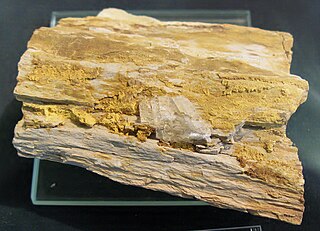
Carnotite is a potassium uranium vanadate radioactive mineral with chemical formula K2(UO2)2(VO4)2·3H2O. The water content can vary and small amounts of calcium, barium, magnesium, iron, and sodium are often present.
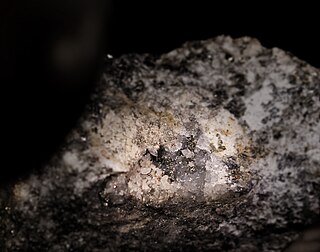
The mineral petzite, Ag3AuTe2, is a soft, steel-gray telluride mineral generally deposited by hydrothermal activity. It forms isometric crystals, and is usually associated with rare tellurium and gold minerals, often with silver, mercury, and copper.

Sylvanite or silver gold telluride, chemical formula (Ag,Au)Te2, is the most common telluride of gold.
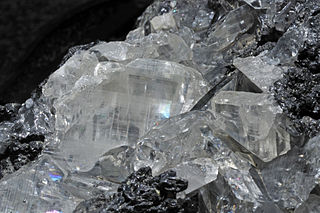
Anglesite is a lead sulfate mineral with the chemical formula PbSO4. It occurs as an oxidation product of primary lead sulfide ore, galena. Anglesite occurs as prismatic orthorhombic crystals and earthy masses, and is isomorphous with barite and celestine. It contains 74% of lead by mass and therefore has a high specific gravity of 6.3. Anglesite's color is white or gray with pale yellow streaks. It may be dark gray if impure.
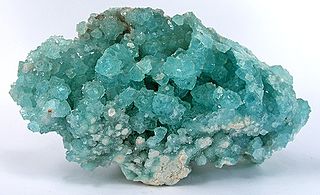
Boracite is a magnesium borate mineral with formula: Mg3B7O13Cl. It occurs as blue green, colorless, gray, yellow to white crystals in the orthorhombic - pyramidal crystal system. Boracite also shows pseudo-isometric cubical and octahedral forms. These are thought to be the result of transition from an unstable high temperature isometric form on cooling. Penetration twins are not unusual. It occurs as well formed crystals and dispersed grains often embedded within gypsum and anhydrite crystals. It has a Mohs hardness of 7 to 7.5 and a specific gravity of 2.9. Refractive index values are nα = 1.658 - 1.662, nβ = 1.662 - 1.667 and nγ = 1.668 - 1.673. It has a conchoidal fracture and does not show cleavage. It is insoluble in water (not to be confused with borax, which is soluble in water).

Alunite is a hydroxylated aluminium potassium sulfate mineral, formula KAl3(SO4)2(OH)6. It was first observed in the 15th century at Tolfa, near Rome, where it was mined for the manufacture of alum. First called aluminilite by J.C. Delamétherie in 1797, this name was contracted by François Beudant three decades later to alunite.
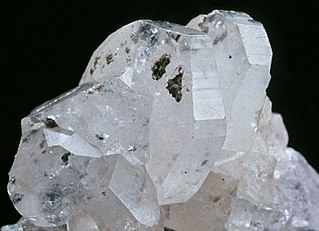
Phenakite or phenacite is a fairly rare nesosilicate mineral consisting of beryllium orthosilicate, Be2SiO4. Occasionally used as a gemstone, phenakite occurs as isolated crystals, which are rhombohedral with parallel-faced hemihedrism, and are either lenticular or prismatic in habit: the lenticular habit is determined by the development of faces of several obtuse rhombohedra and the absence of prism faces. There is no cleavage, and the fracture is conchoidal. The Mohs hardness is high, being 7.5–8; the specific gravity is 2.96. The crystals are sometimes perfectly colorless and transparent, but more often they are greyish or yellowish and only translucent; occasionally they are pale rose-red. In general appearance the mineral is not unlike quartz, for which indeed it has been mistaken. Its name comes from Ancient Greek: φέναξ, romanized: phénax, meaning "deceiver" due to its close visual similarity to quartz, named by Nils Gustaf Nordenskiöld in 1833.

Samarskite is a radioactive rare earth mineral series which includes samarskite-(Y), with the chemical formula (YFe3+Fe2+U,Th,Ca)2(Nb,Ta)2O8 and samarskite-(Yb), with the chemical formula (YbFe3+)2(Nb,Ta)2O8. The formula for samarskite-(Y) is also given as (Y,Fe3+,U)(Nb,Ta)O4.

Tephroite is the manganese endmember of the olivine group of nesosilicate minerals with the formula Mn2SiO4. A solid solution series exists between tephroite and its analogues, the group endmembers fayalite and forsterite. Divalent iron or magnesium may readily replace manganese in the olivine crystal structure.

Triplite is a rare phosphate mineral with formula: (Mn, Fe)2PO4(F, OH). It occurs in phosphate-rich granitic pegmatites typically as irregular brown opaque masses. Triplite was first described in 1813 for an occurrence in Chanteloube, Limousin, France. The name is from the Greek triplos for triple, in reference to the three cleavage directions. In color and appearance, it is very similar to rhodocrosite, another manganese bearing mineral. Chemically, it is also quite similar to triploidite the difference being that triplite is fluorine dominant while triploidite is hydroxide dominant.

Enargite is a copper arsenic sulfosalt mineral with formula Cu3AsS4. It takes its name from the Greek word enarge, "distinct". Enargite is a steel gray, blackish gray, to violet black mineral with metallic luster. It forms slender orthorhombic prisms as well as massive aggregates. It has a hardness of 3 and a specific gravity of 4.45.

Franckeite, chemical formula Pb5Sn3Sb2S14, belongs to a family of complex sulfide minerals. Franckeite is a sulfosalt. It is closely related to cylindrite.
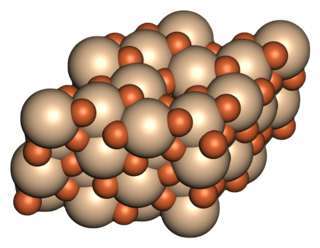
Xifengite (Fe5Si3) is a rare metallic iron silicide mineral. The crystal system of xifengite is hexagonal. It has a specific gravity of 6.45 and a Mohs hardness of 5.5. It occurs as steel gray inclusions within other meteorite derived nickel iron mineral phases.
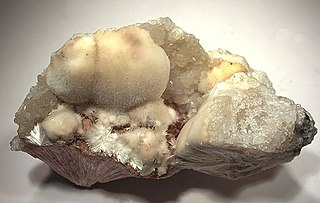
Xonotlite, or eakleite, is a mineral of general formula Ca6Si6O17(OH)2 named by the German mineralogist Karl Friedrich August Rammelsberg in 1866. The name originates from its discovery locality, Tetela de Xonotla, Puebla, Mexico. Although it was discovered in 1866, it was first described in 1959. It is approved by the IMA, but it is a grandfathered species, meaning the name supposedly represents a valid species til this day.

Margarite is a calcium rich member of the mica group of the phyllosilicates with formula: CaAl2(Al2Si2)O10(OH)2. It forms white to pinkish or yellowish gray masses or thin laminae. It crystallizes in the monoclinic crystal system. It typically has a specific gravity of around 3 and a Mohs hardness of 4. It is translucent with perfect 010 cleavage and exhibits crystal twinning.

Siderophyllite is a rare member of the mica group of silicate minerals with formula KFe2+2Al(Al2Si2)O10(F,OH)2.
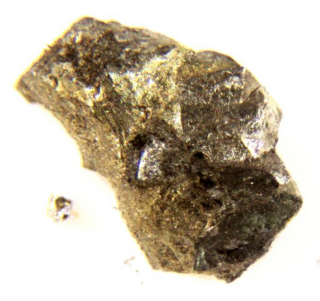
Vulcanite is a rare copper telluride mineral. The mineral has a metallic luster, and has a green or bronze-yellow tint. It has a hardness between 1 and 2 on the Mohs scale. Its crystal structure is orthorhombic.

Baumhauerite (Pb3As4S9) is a rare lead sulfosalt mineral. It crystallizes in the triclinic system, is gray-black to blue-gray and its lustre is metallic to dull. Baumhauerite has a hardness of 3.
Guettardite is a rare arsenic-antimony lead sulfosalt mineral with the chemical formula Pb(Sb,As)2S4. It forms gray black metallic prismatic to acicular crystals with monoclinic symmetry. It is a dimorph of the triclinic twinnite.



















